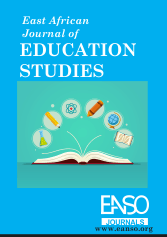Financing Higher Education in Kenya, 1960-2012
Abstract
In the last two decades or so Kenya has witnessed increased demand for university education. This has forced education planners to experiment with a number of strategies to admit these increased numbers of qualified students to existing public universities. These strategies have seen remarkable flexibility in public university programs and admission requirements. Some of these strategies include: evening programs, weekend programs, holiday programs, and open and distance learning programs. But one which has raised enough public attention is the variedly labeled parallel, module two or self- sponsored students programs. Although this program has substantially increased access to public university education in Kenya, it has equally been criticized particularly on its ability to deliver quality university education. The argument has been that the programs were primarily tasked with the purpose of raising income and ensuring institutional survival in the prevailing harsh economic conditions. What is however unknown is the extent to which the program has promoted quality training for students and improved skills for public university academic staff. The brief paper seeks to address this gap. The paper is extensive review of secondary data and personal observations. The paper concludes that the introduction of cost sharing and the increasing need for the universities to fundraise to effectively meet the budgetary deficits has negatively affected the quality of public university education in Kenya
Downloads
References
Ayot, H.O & Briggs, H. (1992). Economics of Education. Nairobi: Educational research and publication. (ERAP).
Cheboi, Benjamin. (2008). Student Loan Design. Buffalo, NY: International Comparative Higher Education Finance and Accessibility Project.
Eshiwani, G. S. (1990). Implementing Educational Policies in Kenya. World Bank Discussion Papers No. 85. Africa Technical Department Series.
Johnstone, D. B. (2006). Financing higher education: Cost-sharing in international perspective. Rotterdam/Boston, MA: Sense/Boston College Center for International Higher Education.
Johnstone, D. B. (2009). Worldwide trends in financing higher education: A conceptual framework. Financing access and equity in higher education.
Kalai, J. M. (2011). Expansion of University Education in Kenya: The Challenges and issues in balancing access and equity. A Journal of KIM School of Management, 1, 3- 11.
Kalai, J.M. (2010). Expansion of university education in Kenya: challenges and issues in balancing access and quality. Management digest, ISSN-2074-4730. Kenya Institute of Management, Pp4-10.
Kiamba, C. (2004). Private Sponsored Students and other Income –Generating Activities at the University of Nairobi. Journal of Higher Education in Africa.2920, PP53-73.
Kiamba, C. (2004). The experience of privately sponsored studentship and other income generating activities at University of Nairobi. Journal
Kigotho, W. (1995). “Kenya’s Dying Universities,” Times Higher Education Sumiement (September 1995).
Munyae, M. (2010). Interrogating the Quality of Postgraduate Research in African Universities: Some Reflections from an Examiner. Paper Presented During the CODESRIA General Assembly, Rabat December 5th- 9th 2011
Mwiria, Kilemi and Mulati S. Nyukuri. (1994). The Management of Double Intakes: A Case Study of Kenyatta University.
Ngome, J.(2013). The Growth of Universities in Kenya. CODESRIA.
Nyaigoti, C. (2004). Reforming Higher Education in Kenya: Challenges, Lessons, and Opportunities. Paper presented during the State University of New York Workshop with the Parliamentary Committee on Education, Science and Technology, Naivasha-Kenya
Ogot, B. (2005). History as Destiny and History and Knowledge: Being Reflection of the Problem of Historicity and Historiography (Kisumu: Anyange Press).
Ooro, S. (2009). “The Quest for Inclusive Education in Kenya: A Vivisection of Concerns, Policies and Reform Initiatives. OCIDES
Otiende, J. (1986). ‘Alternative Future in Higher Education in the Third World: The case of Kenya.’ A paper presented in a symposium on Higher Education in Developing World in Switzerland.
Otieno, W. (2004). “Student Loans in Kenya: Past Experiences, Current Hurdles and Opportunities for the Future”. Boston College and Council for the Development of Social Science Research in Africa. Vol. 2, No. 2. 2004, pp. 75-99
Peter Materu, 2007. "Higher Education Quality Assurance in Sub-Saharan Africa : Status, Challenges, Opportunities, and Promising Practices," World Bank Publications - Books, The World Bank Group, number 6757, December.
Republic of Kenya (GOK). (1988). Report of the Presidential Working Party on Education and Manpower Training for the Next Decade and Beyond. Kamunge Report, Government Printer, Nairobi.
Republic of Kenya. (2009). Financing University Education in Kenya: A Report to the Ministry of Higher Education Science and Technology. Nairobi. Government Printer.
Sawyerr, A. (2004). “Challenges Facing African Universities: Selected Issues”. African Studies Review (2004) Vol. 47, No. 1, 1-59.
Sifuna, D. N. (1990). Development of education in Africa: The Kenyan experience. Initiatives Limited.
World Bank, (1988). Education in Sub-Saharan Africa: Policies for adjustment, revitalization, and expansion, Washington DC: International Bank of Development and Reconstruction.
Copyright (c) 2024 Samwel Ongwen Okuro

This work is licensed under a Creative Commons Attribution 4.0 International License.




























